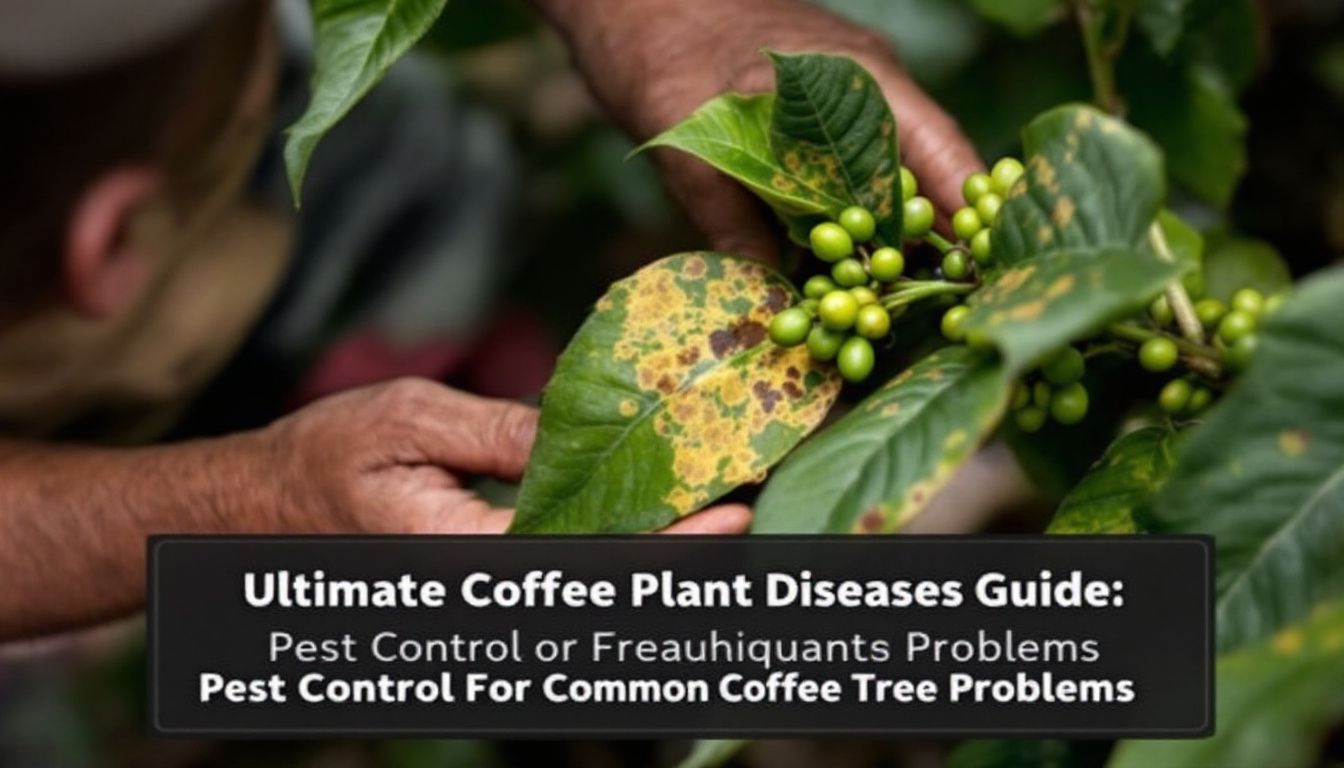Ultimate Coffee Plant Diseases Guide: Pest Control For Common Coffee Tree Problems
Your coffee plants show yellow spots on their leaves. Brown patches spread across the berries. These signs point to plant diseases that hurt your coffee trees. This Coffee Plant Diseases Guide helps you spot and fix common problems fast.
Did you know that coffee diseases cause £500 million in losses each year? Coffee leaf rust alone can kill 80% of your crop. But don’t worry – you can protect your plants with the right steps.
This guide shows you how to spot 4 major coffee diseases. You’ll learn simple ways to stop them before they harm your trees. Plus, you’ll get clear tips on when to treat your plants.
Ready to save your coffee trees?

What Are The Most Common Coffee Plant Diseases?
Coffee plants face many diseases that can ruin your crop. Your coffee trees need quick action against these problems, from rust spots on leaves to rotting berries.
Leaf Rust (Hemileia Vastatrix)
Leaf rust affects your coffee plants severely. The fungus Hemileia vastatrix moves quickly through wind and rain, creating orange dust on leaf undersides. Since its discovery in Africa in 1861, this pest causes damage to crops globally.
The disease thrives at temperatures around 21°C and leads to leaf drop.
Your plants suffer substantial losses from this disease. In 2012, leaf rust caused over £1 billion in damage to Central American farms. The fungus reduces crop yields by 30-50%, resulting in decreased bean production.
Your plants require immediate action when orange spots appear to prevent spreading.
Coffee Berry Disease
Coffee berry disease affects coffee plants severely in Africa. The fungus _Colletotrichum kahawae_ forms dark, sunken spots on green berries. Your coffee plants can lose up to 90% of their yield if left untreated.
The disease begins at the trunk and spreads to the tips of branches.
Your main protection includes copper fungicides and prompt removal of infected berries. The disease causes berries to drop early and become dry, black lumps. Dark patches appear on green coffee cherries first.
Apply copper-based products on your plants before the rainy season begins. Remove any infected berries immediately to prevent the spread.
Brown Eye Spot Disease
Brown eye spot affects coffee plants through the fungus Cercospora coffeicola. Your plants show brown spots with dark borders on their leaves, leading to yellow patches and leaf drops.
The disease grows in temperatures between 20-28°C and creates new spores every 7-10 days in warm, damp weather.
Your infected plants need immediate treatment to control the spread. Clear dead plant parts from the ground, plant shade trees, and apply nitrogen-rich fertilisers. The fungus spreads through wind, water splashes, and people working with the plants.
Maintain a clean and dry coffee farm to prevent this disease.
Root Rot Diseases
Root decay affects coffee plants through fungi like Armillaria sp., causing damage to your coffee trees. Soil with poor water flow and excess moisture creates conditions for these harmful fungi to affect plant roots.
Your plants display these signs: yellow leaves fall, roots become black, and stems decay.
Control root decay by maintaining well-drained and dry soil. Plant your coffee trees with enough space between them for proper air circulation. Test the soil moisture before watering – excess water causes root issues.
Your coffee plants require proper drainage to prevent decay from affecting other trees.
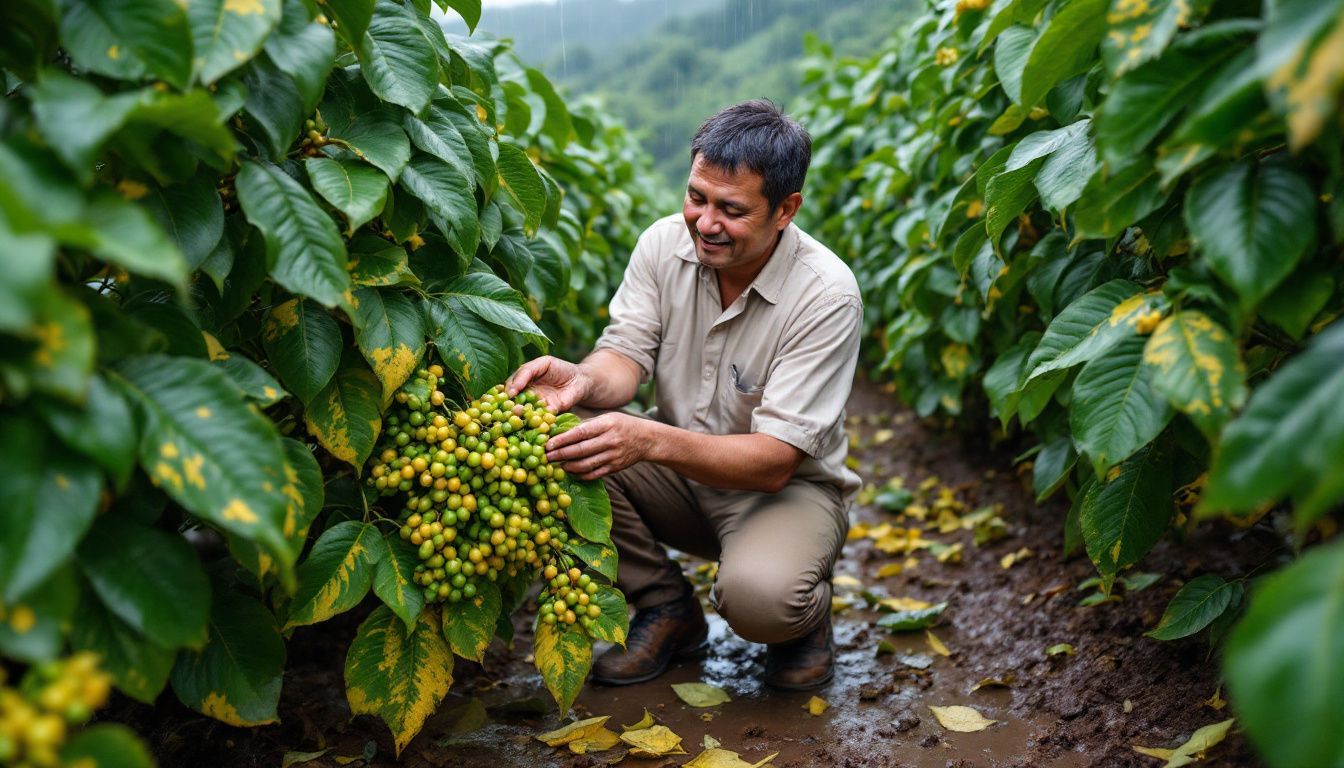
How Does Coffee Leaf Rust Affect Plants?
Coffee leaf rust starts as yellow spots on leaves and spreads fast, making leaves drop off and stopping plants from making food – read on to learn how this nasty disease can cut your coffee harvest by half.
Early Signs And Symptoms
Leaf rust displays visible signs on plants before major damage occurs. Early detection helps protect your arabica plants from severe harm.
- Small pale yellow spots appear on leaf undersides
- Orange-coloured dust forms in patches across leaves
- Leaf spots grow larger and turn brown within 5-7 days
- Plants start dropping leaves too soon
- Yellowing spreads from leaf tips inward
- Dark patches form on green berries
- Fruit fails to ripen at normal speed
- Light-weight beans develop with poor taste
- Plant stems show black spots near leaf joints
- New growth appears stunted and weak
- Leaves curl up at edges
- Brown patches spread across leaf surfaces
- Stems lose their healthy green shade
- Branch tips start dying back
- Root area shows signs of decay
Disease Progression Stages
Coffee leaf rust progresses in distinct stages during plant infection. Your coffee trees display these specific signs as the disease develops:
- Pale yellow spots form on leaf undersides (2-3mm wide)
- Orange-yellow powder appears in spots after 5-7 days
- Spots expand and combine into 2-3cm patches
- Powdery spores move to nearby leaves via wind and rain
- Dark brown spots take over yellow areas in 3-4 weeks
- Infected leaves fall after 5-6 weeks
- New spores develop and spread to other plants within 7 days
- Tree loses 50-70% of leaves in severe cases
- Fruit yield reduces by 30-80% in heavy infections
- Plant death happens if untreated for 3-4 months
- Spores remain active in soil for up to 6 weeks
- New infections begin from soil spores during wet weather
- Plants experience reduced growth after multiple infections
- Berries mature too early and lack proper flavour
- Root system becomes weak from lack of nutrients
Economic Impact On Coffee Production
Leaf rust disease affects global coffee farms severely, causing £500 million in yearly losses. Your coffee yields decrease by 30% to 50% when this disease affects the plants. The damage moves quickly through coffee plantations worldwide.
British farmers spend large sums on fungicides to combat these diseases. Many pests show resistance to these treatments, making control difficult and more expensive. Your most effective defence comes from selecting resistant plant varieties and using natural pest controls to reduce growing costs.
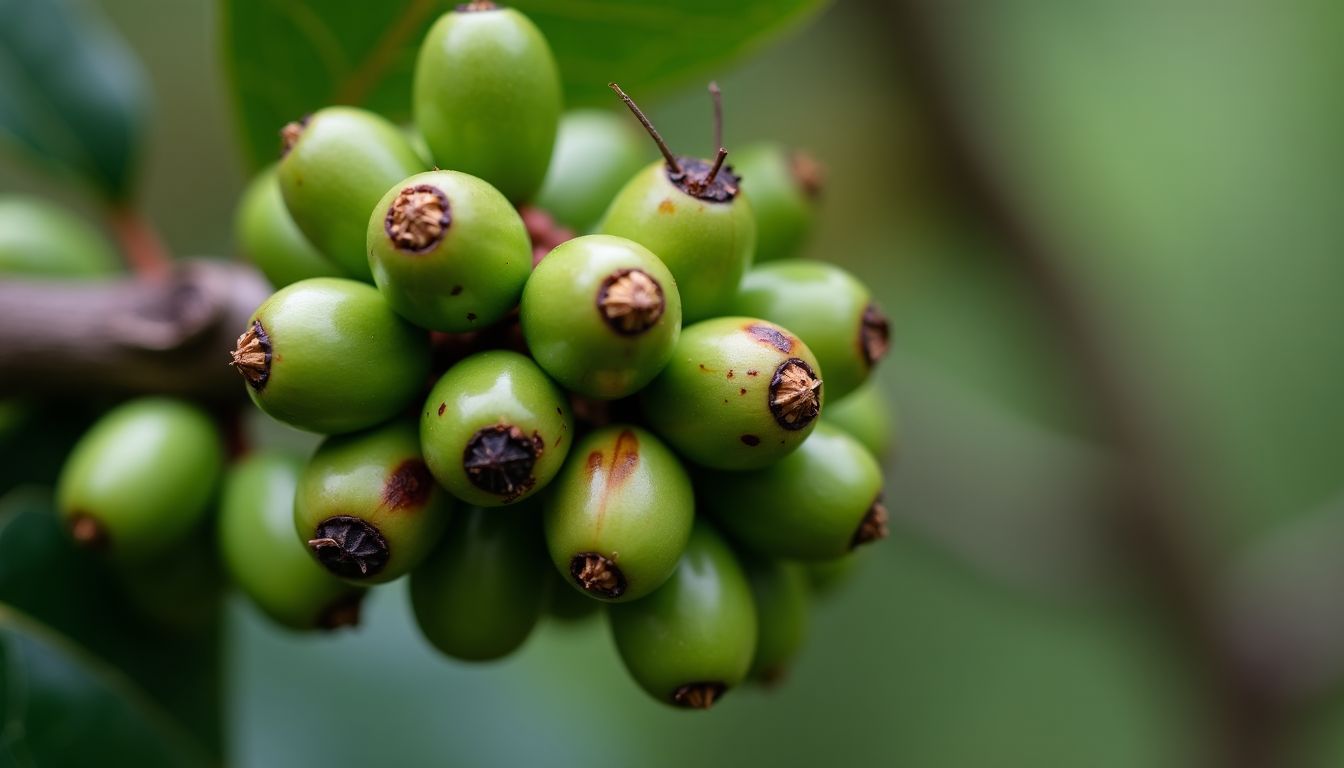
What Are The Signs Of Coffee Berry Disease?
Coffee berry disease shows up as dark spots on green coffee cherries. The spots grow bigger and sink into the fruit, making the cherries rot and fall off before they ripen.
Initial Symptoms
Coffee fruit disease begins with small spots on fresh berries. These marks appear as dark, wet patches that expand with time.
- Small water spots show on green berries, measuring 1-2mm across
- Dark brown patches create sunken areas on the fruit surface
- Pink spores develop on damaged spots during wet weather
- Young berries drop before spots become visible
- Light-coloured scabs form with cork-like texture
- Berry stalks break and drop fruits early
- Pale lesions spread across 30% of the berry surface
- Rot affects whole berries within 5-7 days
- Infected fruits display signs of decay at the attachment point
- Spore masses form in circular patterns on damaged areas
- Early stage spots feel soft to touch
- Fruit skin deteriorates in humid conditions
Disease Development
Green berries are most susceptible between weeks 7 to 18 after flowering. The disease progresses from the trunk to branch tips in a distinct pattern.
- Rain splashes distribute spores rapidly across berry clusters, creating black and sunken spots
- Cool temperatures combined with high humidity accelerate damage in 48 hours
- Dark lesions create rings around berries as the first infection sign
- Affected fruits fall prematurely, reducing yields by 50-80%
- Shade trees reduce rain splash and modify local weather conditions to decrease spread
- Spots merge to cover entire berries within 5-7 days
- Black patches become brown as berries shrivel and dry out
- Fresh spores develop in wet spots after 10 days
- New infections begin from old berry spots during rainy periods
- Branch tips display most damage as disease advances from trunk
- Green fruits deteriorate quickest in temperatures below 20°C
- Wet leaves aid spores in attaching and penetrating berry skin
- Berry clusters beneath shade trees exhibit reduced damage
- Fungal activity reaches its peak in morning dew or light rain
- Fruit stems blacken and detach easily
Fruit Damage Assessment
Coffee berries display damage from diseases. Dark, sunken spots show on your green coffee fruits. The spots move quickly and cause the berries to rot. Your infected berries drop off too early, before they ripen.
Pink spores form on wet spots during rainy days.
You’ll notice pale, scabby marks on affected coffee fruits. These marks become corky and rough. Diseased berries shrivel up and change into hard, dry lumps. Your coffee yield reduces when fruits get sick.
Poor fruit creates fewer coffee beans for sale.

How Can Coffee Plant Diseases Be Prevented?
You can stop coffee plant diseases before they start with good care and clean tools. Smart planning helps you catch problems early – like keeping your plants spaced out, picking the right spot to grow them, and using clean water.
Cultural Control Methods
Cultural control methods stop coffee plant diseases without chemicals. These natural steps protect your coffee plants and keep them strong.
- Plant spacing: Space coffee trees 2.5 metres apart for good air flow and less disease spread.
- Shade control: Cut back shade trees twice yearly to let in 60% sunlight, which fights fungal growth.
- Pruning rules: Remove dead branches every 3 months and do full pruning once every 5 years.
- Clean tools: Wipe all garden tools with alcohol before and after use to stop disease spread.
- Soil care: Test soil pH levels every 6 months and add organic matter to reach ideal 6.0-6.5 pH.
- Water habits: Water at ground level in early morning to keep leaves dry and stop leaf rust.
- Weed control: Clear weeds in a 1-metre circle around each coffee plant monthly.
- Plant nutrition: Feed plants with balanced NPK fertiliser four times per year.
- Field monitoring: Check plants weekly for spots, rust, or odd colours on leaves.
- Plant selection: Pick disease-resistant coffee types suited to your growing area.
- Crop timing: Pick coffee cherries as soon as they turn red to stop berry disease.
- Ground cleanup: Remove fallen leaves and fruits daily to stop pest cycles.
Chemical Control Options
Chemical pesticides control coffee plant diseases quickly. Modern coffee farms use three main types of chemicals to control pests and diseases.
Organophosphate Sprays
- Mix with water at 2ml per litre
- Spray directly on leaves and stems
- Controls coffee berry borers and leaf miners
- Apply every 14-21 days in wet season
Pyrethroid Solutions
- Natural plant-based pesticides
- Safe for coffee beans
- Manages mealybugs and aphids
- Needs 3-4 sprays per growing season
Carbamate Products
- Effective pest control for severe cases
- Prevents root rot and fungal growth
- Use 1.5ml per litre of water
- Apply only during dry weather
Organic Alternatives
- Neem oil sprays control soft-bodied pests
- Copper-based sprays manage leaf rust
- Sulphur dust prevents powdery mildew
- Mix fresh batches for each use
Safety Rules
- Wear gloves and masks while spraying
- Spray early morning or late evening
- Keep pets away for 24 hours
- Store chemicals in locked space
Application Tips
- Check weather before spraying
- Mix exact amounts listed on labels
- Clean tools after each use
- Wait 7 days between treatments
Resistant Variety Selection
Coffee plants need strong defences against diseases. Uganda’s KR1 to KR10 coffee types fight off coffee wilt disease very well. These special plants keep your coffee farm safe without lots of chemicals.
Your choice of tough coffee plants helps stop diseases from spreading fast.
Many coffee farms now grow just one type of coffee plant. This makes the plants weaker against diseases. Pick coffee types that can stand up to local threats in your area. Strong coffee plants save you money on sprays and keep your farm healthy.
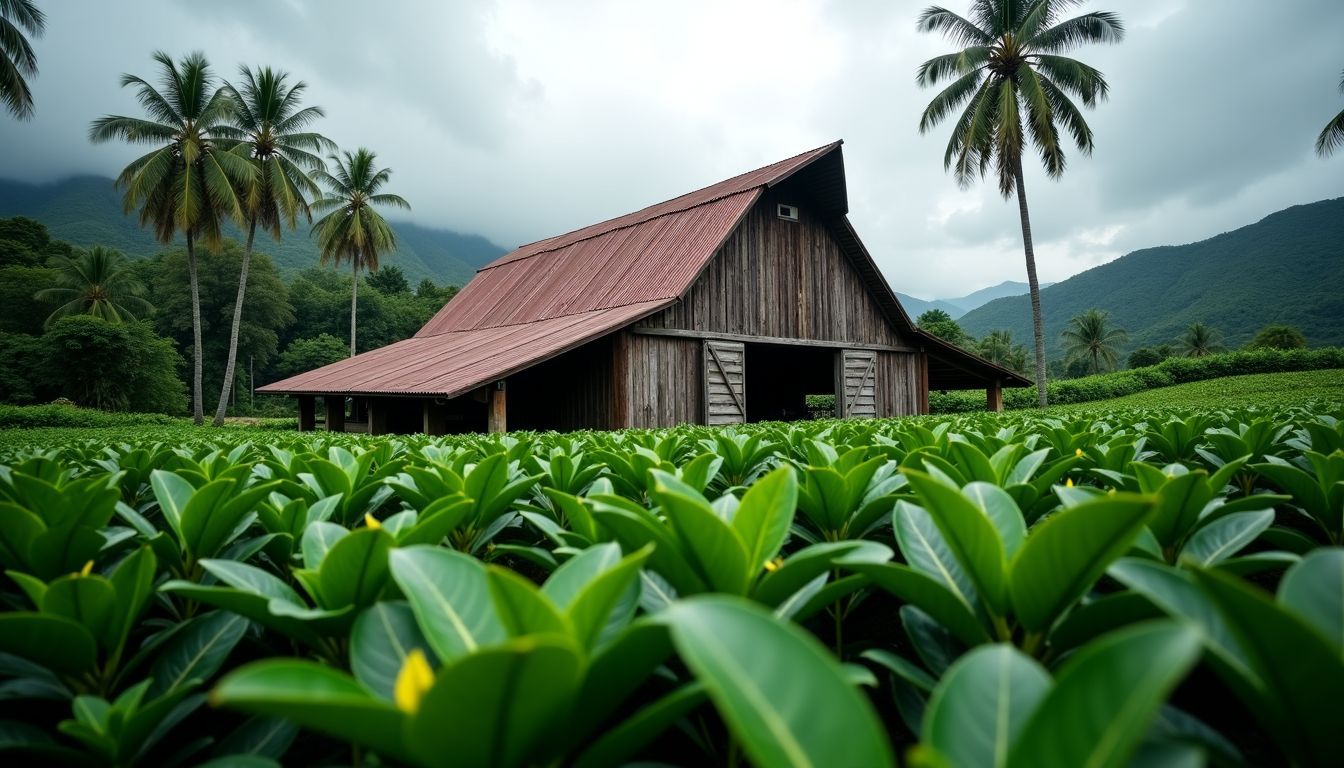
When Should Coffee Plants Be Treated For Disease?
You need to treat coffee plants for diseases right before the wet season starts – this stops problems before they grow big. Want to learn about the best times to check your plants? Keep reading….
Seasonal Timing
Coffee diseases appear at particular times in the growing season. Most fungal issues begin in spring as temperatures reach 21°C alongside high humidity. Leaf rust moves quickly in rainy seasons between March and June across coffee-growing areas.
The dry season from December to February experiences reduced disease activity.
You should check your coffee plants for pests every 14 days in peak disease months. Spring carries the highest chance of coffee berry disease, and autumn shows increased brown eye spot cases.
You’ll achieve the best results with fungicide sprays in early morning before 10 AM, requiring follow-up treatments every 21-28 days in wet conditions.
Weather Conditions
High temperatures and moisture create conditions where plant diseases thrive. Your coffee plants become more susceptible during rainy periods with temperatures of 21-25°C and humidity exceeding 85%.
These weather patterns allow fungal spores to multiply across leaf surfaces.
Alternating dry periods and rainfall increase disease occurrence in your coffee farm. Wind carries spores up to 30 metres, spreading leaf rust and other fungi across plants. Damp soil and wet leaves require 6 hours to dry completely, so morning dew can cause new infections on your crops.
Treatment Intervals
Apply copper fungicides to your coffee plants every 14 to 21 days in wet seasons. Your spray schedule should match local weather patterns and disease risks in your area. Coffee leaf rust requires more frequent applications – use copper solutions every 10 days when humidity remains above 85%.
Check your plants weekly for new disease spots or leaf damage. Space chemical treatments 3-4 weeks apart in dry conditions. Include balanced fertilisers with your spray programme to support plant health.
Remove fallen leaves and old fruit from under trees before each spray application.
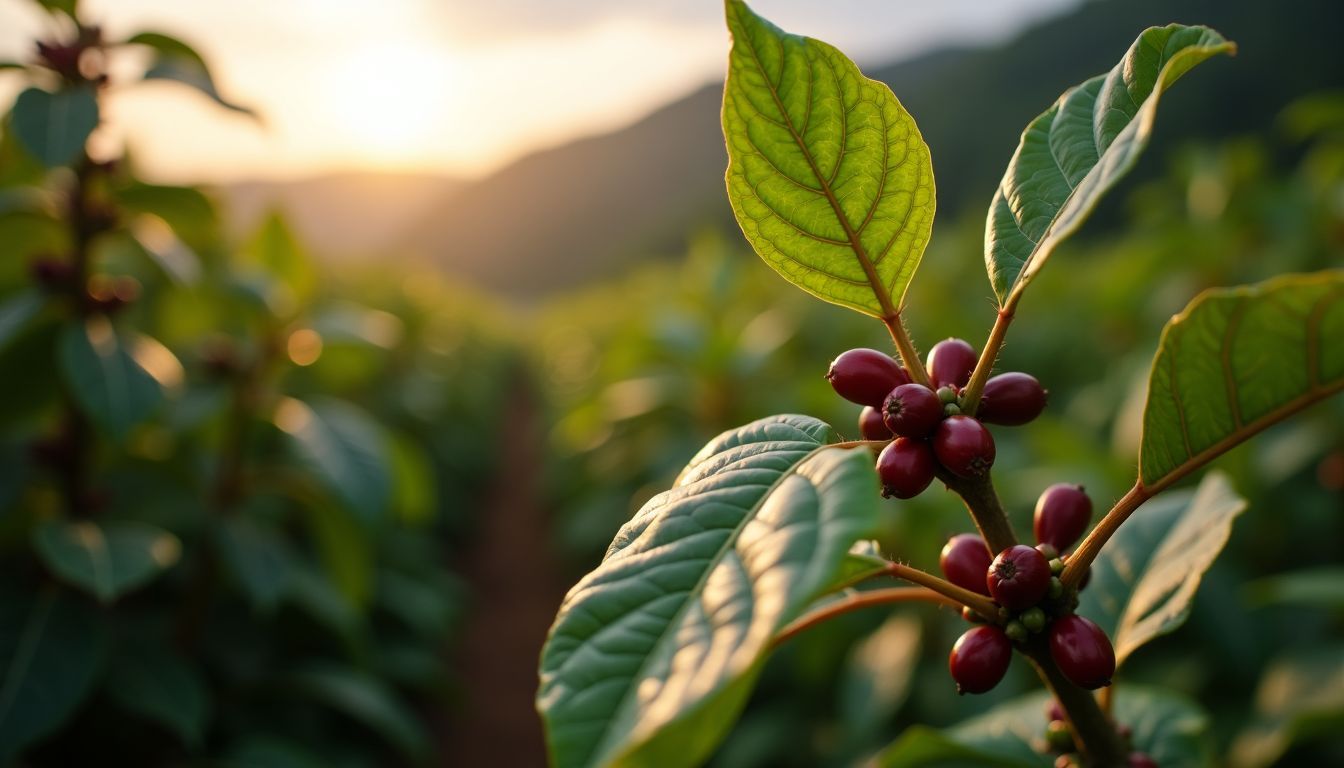
How Do Environmental Factors Impact Coffee Plant Diseases?
Weather plays a big role in how sick your coffee plants get. Hot, wet air makes it easy for plant diseases to spread through your coffee farm.
Temperature Effects
High temperatures affect your coffee plants directly. Coffee plants begin showing damage at 30°C, causing yellowing leaves and reduced growth rates. Your plants become more vulnerable to pests and diseases during warmer conditions.
The heat disrupts leaf photosynthesis, reducing your farm’s coffee production.
Your coffee plants perform better in cooler environments. Plants growing above 86°F display stress symptoms through falling leaves and weakened stems. Warm conditions help diseases move quickly across coffee farms.
Your plants shed leaves more rapidly in warm weather, reducing your harvest yields.
Humidity Levels
Humidity levels between 70-80% create perfect conditions for coffee plant diseases to spread. Your coffee plants face serious risks from fungal growth at these moisture levels, leading to leaf rust and cercospora spots.
Moist air causes spores to multiply fast on coffee leaves and stems.
Your plants need proper spacing to let air move freely through branches. Coffee farms must keep 1200-1800mm yearly rainfall for healthy growth while avoiding wet leaves and stems. Space your coffee trees 2-3 metres apart to reduce moisture build-up and stop disease spread.
Soil Conditions
Soil pH levels between 6.0 and 6.5 support excellent growth for coffee plants. Your coffee plants need well-drained soil to prevent root rot from forming. Poor drainage leads to waterlogged roots, making plants weak and sick.
The soil must stay loose and airy to let roots breathe properly.
Good soil care prevents many plant diseases before they start. Mix organic matter into your soil to improve drainage and air flow. Test your soil’s pH twice per year using a testing kit.
Poor soil causes stunted growth, yellow leaves, and makes plants more likely to get sick. Root rot develops quickly in wet, heavy soils that don’t drain.
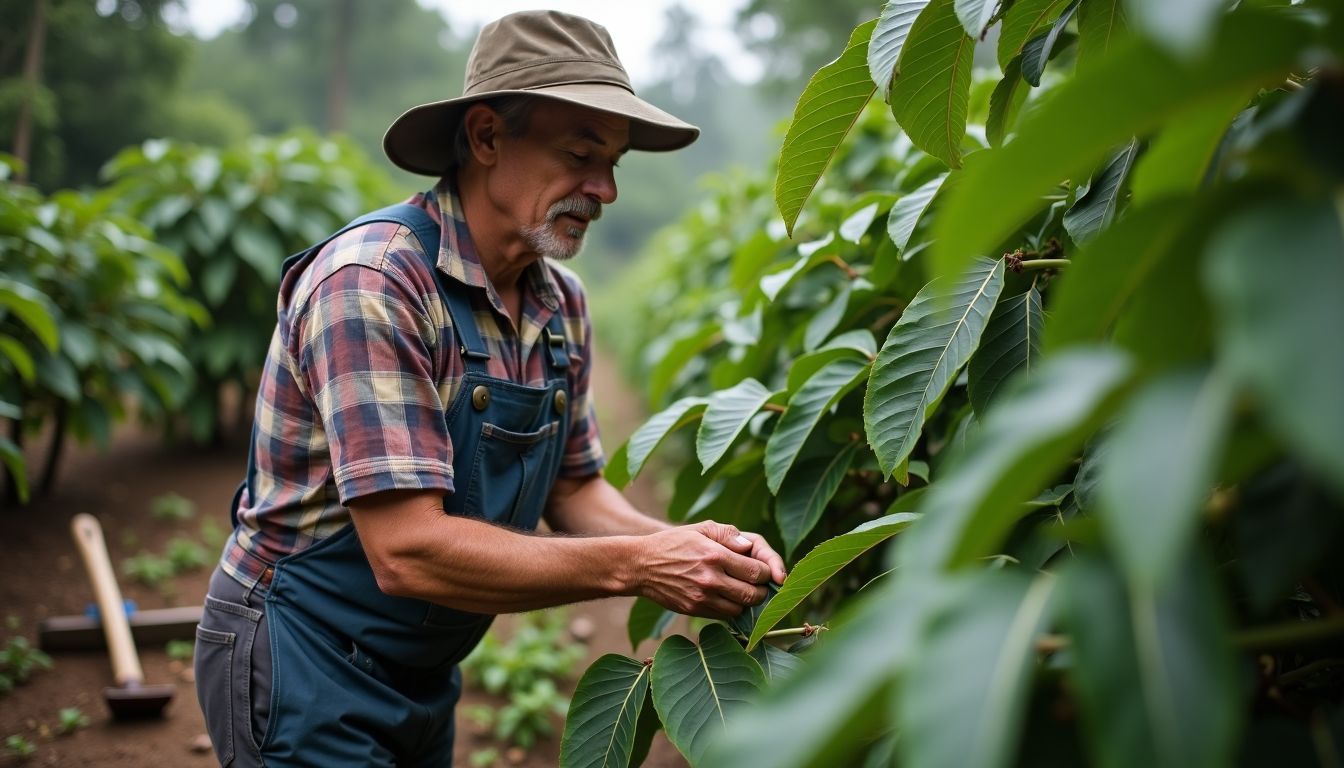
What Are The Best Disease Management Practices?
Check your coffee plants daily for signs of disease and keep clear notes of any changes. A mix of natural pest control, good soil care, and smart spraying will stop most plant problems before they grow big.
Integrated Disease Management
Integrated Disease Management (IDM) combines different methods to control coffee plant diseases. Your coffee plants maintain health through coordinated steps that complement each other.
- Combine disease-resistant coffee plants with good care methods
- Plant strong coffee types that resist leaf rust
- Space plants 2 metres apart for air flow
- Keep soil pH at 6.0-6.5
- Use living helpers to control pests
- Add beneficial bugs that eat harmful ones
- Place helpful fungi near roots
- Grow shade trees to protect against harmful insects
- Give plants proper food and water
- Add fertiliser 3 times yearly
- Water early morning only
- Keep leaves dry to prevent fungus
- Monitor plants regularly
- Check leaves each week
- Identify problems fast
- Document what you see
- Clean up often
- Pick up fallen leaves daily
- Remove sick branches right away
- Clear weeds monthly
- Time your actions right
- Spray before rain starts
- Prune in dry weather
- Plant new trees in spring
- Document what works
- Record which sprays helped
- Track weather patterns
- Save plant growth data
- Prevent problems from spreading
- Clean tools between uses
- Keep sick plants away
- Block pest paths
- Use safe sprays only when necessary
- Start with mild soaps
- Try plant oils first
- Use strong sprays as last option
Monitoring Techniques
Coffee plant monitoring requires daily disease checks. Your coffee trees stay healthy through proper observation methods.
- Review leaves daily for spots, rust, or yellowing – identify issues early on leaf surfaces and undersides
- Monitor pest activity through sticky traps placed 2 metres apart between coffee rows
- Divide your coffee garden into 4 sections for organised pest checks each week
- Take photos of plant damage and keep dated records in a field notebook
- Check soil moisture levels twice weekly using a moisture meter probe
- Count affected cherries on 10 random trees monthly to track disease spread
- Place weather stations to record rainfall, humidity and temperature data
- Use colour charts to match leaf symptoms against known disease patterns
- Mark infected plants with bright tags for easy identification during rounds
- Sample roots from 5 trees quarterly to check for rot or pest damage
- Record treatment dates and results in a digital tracking app
- Make pest maps showing problem spots across your coffee farm
- Schedule checks for early morning when pests are most active
- Record growth stages through weekly plant height measurements
- Record weather changes that might affect plant health
Record Keeping Methods
Record pest and disease information in a simple log book. List dates, locations and signs of leaf damage on each coffee plant. Document affected trees and effective treatments. Your notes help identify patterns in disease spread across your farm.
Maintain a digital chart of daily farm tasks and plant health checks. Photograph affected leaves or fruits to track changes over time. Your records should include pest counts, weather details and spray dates for each field block.
Proper record keeping creates better crop yields through fast problem solving.

How Can Coffee Plants Recover From Disease?
Sick coffee plants can bounce back with proper care and time – read on to learn about the steps you need to take to help your plants heal from diseases and get back to growing healthy beans.
Recovery Timeline
Coffee plants need proper care to recover from diseases. Your infected plants will show signs of improvement within 4-8 weeks with the right treatment.
- Begin basic plant care immediately after noticing signs – remove dead leaves and prune affected branches
- Clean all fallen leaves and debris around the coffee bush within 24 hours of treatment
- Apply copper-based fungicide spray to leaves every 14 days for 2 months
- Feed plants with balanced NPK fertiliser after 3 weeks of treatment
- Monitor soil pH levels – maintain between 6.0-6.5 for ideal recovery
- Watch for new leaf growth after 4-6 weeks as first sign of plant healing
- Check moisture levels daily – keep soil damp but not wet
- Spray plants with liquid seaweed solution every 21 days to improve immunity
- Review pest activity weekly during recovery phase
- Wait 3-4 months for full plant recovery before normal fruit production resumes
- Analyse leaf tissue samples monthly to track nutrient uptake
- Position plants properly (2-3 metres apart) to prevent disease spread during recovery
- Document treatment dates and plant responses for future reference
Treatment Methods
Proper treatment stops plant diseases fast. Your infected plants require immediate action through tested methods.
- Spray copper fungicides on leaves every 21 days during wet seasons to kill rust spores
- Apply triazole-based sprays directly on berry disease spots when dark lesions appear
- Mix systemic fungicides with water at 2ml per litre for complete plant coverage against leaf spots
- Cut off infected branches 4 inches below damage and burn them to prevent disease spread
- Paint tree trunks with lime wash mixed with copper sulphate to stop bark diseases
- Use neem oil solution (5ml per litre) as a natural fungicide for minor infections
- Drench soil with fungicide solution monthly to address root rot issues
- Remove all fallen leaves and berries from ground weekly to break disease cycles
- Thin out dense branches for better air circulation through plants and reduce humidity
- Space plants 2 metres apart to prevent diseases spreading between trees
- Add calcium-rich fertilisers to build stronger plant cell walls against infections
- Install drip irrigation to keep leaves dry while watering roots
- Plant resistant varieties like Catimor that resist common diseases
- Check pH levels monthly and maintain soil between 6.0-6.5 for good plant health
- Create drainage channels to prevent water pooling around plant bases
Post Disease Care
Your coffee plants need 3-4 months to recover after disease treatment. Feed your plants balanced nutrients through NPK fertiliser at 20-5-20 ratio. Keep the soil pH at 6.0-6.5 for good recovery.
Remove dead leaves and branches to support new growth.
Your daily plant checks will identify any new disease signs quickly. Apply copper-based fungicides every 14 days in wet weather. Record all treatments and plant responses. Position your plants 2 metres apart to improve air flow and reduce disease risks.
Use drip irrigation to keep leaves dry.
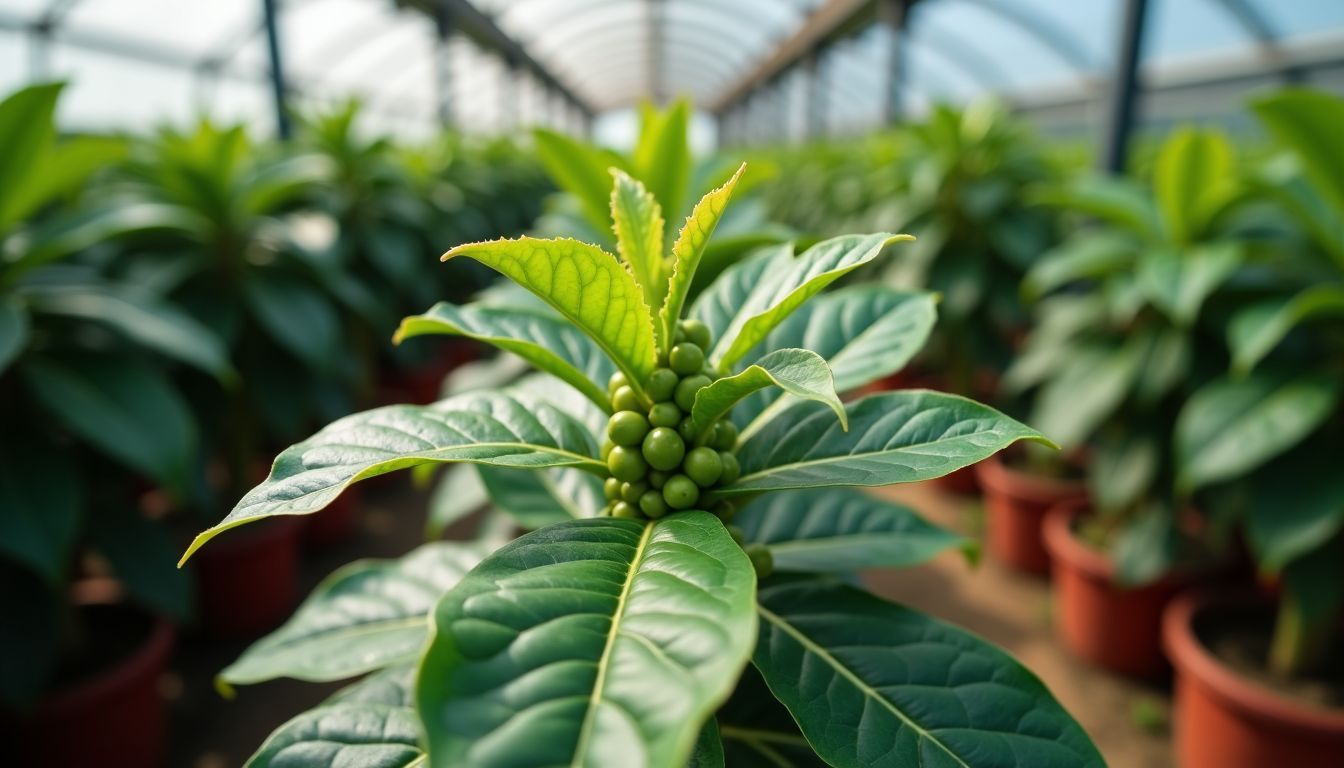
Conclusion
Coffee plant diseases need quick action and smart care. You must check plants daily for rust spots, berry disease, and root rot signs. Smart pest control starts with clean tools and proper plant spacing.
Regular pruning and good air flow stop most fungal problems. Disease-resistant coffee varieties give better protection against common issues. Coffee plants bounce back fast with proper care and the right growing conditions.
FAQs
1. What are the most common coffee diseases that affect coffee plants?
Coffee rust, black rot, and fungal infections are the main diseases. They affect both arabica coffee and robusta plants, causing leaf spots and necrosis.
2. How do coffee borers damage coffee trees?
Coffee borers are beetles that dig into cherries. Their larvae feed on the beans inside. This pest causes heavy damage in many coffee-producing countries.
3. What signs show my coffee plant has a disease?
Look for yellowing of leaves, leaf spots, and dieback. Check the underside of leaves for rust pustules. Watch for changes in the plant’s ability to photosynthesise.
4. Does altitude affect coffee plant diseases?
Yes! Coffee plants grown at different altitudes face unique problems. Higher spots have less fungal disease risk, while lower areas may see more pest issues.
5. How can I stop pests and diseases in my coffee plants?
Use good nutrition and proper fertilisation. Keep an eye on growing conditions. Act fast when you spot trouble. Some farmers use safe insecticides when needed.
6. Why do some coffee trees lose their leaves too early?
Defoliation happens when pests or diseases attack. Coffee leaf miners, mould, and poor growing conditions can make leaves drop. This hurts the plant’s ability to make food.
